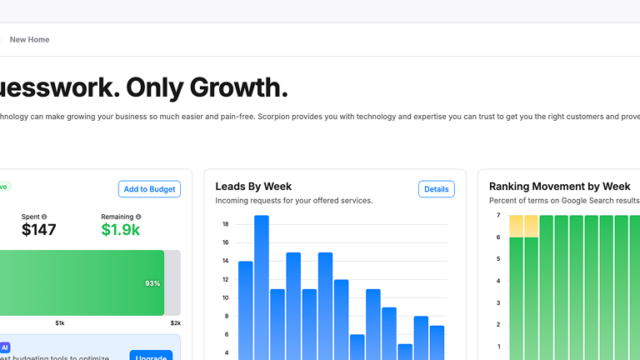Know What’s Working: Understand Your Marketing ROI and Drive More Revenue

Sponsored content by Scorpion.
We hear it every year: advertising is getting more and more expensive, while franchisors are left wondering how to reach revenue goals. To maximize their return, business owners need to understand if their marketing is working, why it’s working–or isn’t–and how to get more out of their marketing spend. Success may look different for every owner, but franchisors and franchisees seeing the most success know which marketing channels deliver revenue and maximize results.
Not All Leads Are Created Equal
While generating leads is important, it’s important to recognize that lead quality significantly impacts your bottom line. Focusing solely on cost-per-lead (CPL) provides an incomplete picture. To truly optimize your marketing spend, you need to understand:
- Lead Value: Which leads are most likely to convert into paying customers?
- Revenue Generation: Which leads ultimately drive the most revenue for your business?
- Return on Investment (ROI): Which marketing channels deliver the highest return on your investment?
By analyzing these factors, you can identify and prioritize high-value leads, ensuring that your marketing efforts are focused on attracting the right customers.
Connecting Marketing Metrics with Revenue
Integrating your marketing data with revenue data provides valuable insights into the ROI of each advertising channel. It’s important to consider that a higher CPL may sometimes be justified if the channel generates a higher volume of qualified leads or leads with a higher customer lifetime value.
For example, a channel with a lower CPL might generate a high volume of leads, but if those leads have a low conversion rate, the overall ROI may be lower than a channel with a higher CPL but a higher conversion rate.
By analyzing lead cost, conversion rates, and revenue generated by each lead, you can make data-driven decisions to optimize your marketing spend and drive revenue growth.
Integrating Your Marketing and Revenue Data: A Powerful Combination
Marketing agencies delivering the most value for their customers are now leveraging technology to bridge the gap between marketing activities and revenue outcomes. By integrating marketing data with a franchise’s Customer Relationship Management (CRM) system, businesses gain a comprehensive view of their marketing ROI.
For example, Scorpion offers a revenue dashboard and roll-up reporting that provides franchise businesses with valuable insights into the effectiveness of their marketing efforts. Scorpion integrates with leading CRMs, like ServiceTitan, to further enhance this capability by providing robust metrics and reporting.
Roxanne Conrad, Chief Operating Officer of Premium Service Brands, highlights the value of this integration: “The integration between Scorpion and ServiceTitan has been tremendously impactful for us.”
This one-of-a-kind partnership between Scorpion and ServiceTitan empowers franchise owners with a centralized view of their data, enabling them to make informed decisions and maximize their marketing strategies and investments.
Using Data to Drive Continuous Improvement
By connecting marketing metrics with revenue data, you can gain a deeper understanding of your marketing performance and identify areas for improvement. This allows you to:
- Optimize Budget Allocation: Invest in the channels that deliver the highest ROI.
- Enhance Marketing Strategies: Refine your campaigns based on data-driven insights.
- Improve Operational Efficiency: Identify and address bottlenecks in the customer journey.
Courtney Spain, Director of Marketing at Premium Service Brands, emphasizes the transformative impact of this data-driven approach: “The partnership with Scorpion and ServiceTitan has really revolutionized the way that our franchisees have access to their metrics and their data.”
By focusing on revenue generation and analyzing integrated data, franchisors can have greater transparency in performance, allowing them to create hyper-local marketing strategies for franchisees. This approach can make it easier to scale marketing efforts across locations and realize results.